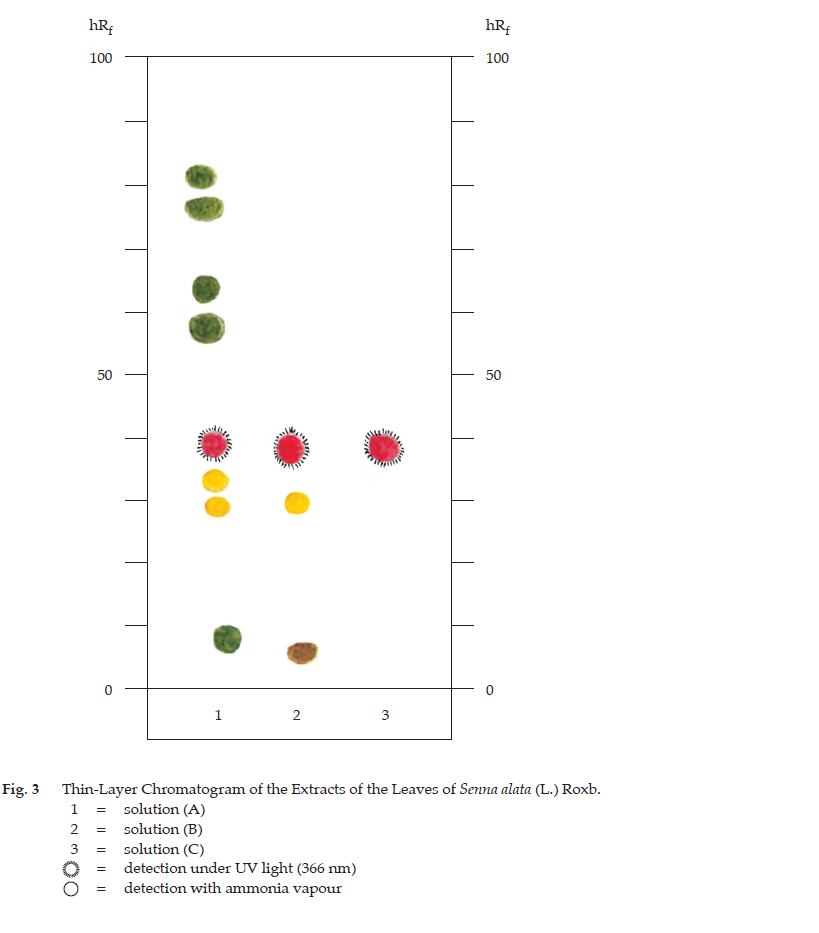ตำรามาตรฐานยาสมุนไพรไทย
Thai Herbal Pharmacopoeia
สำนักยาและวัตถุเสพติด กรมวิทยาศาสตร์การแพทย์ กระทรวงสาธารณสุข
Bureau of Drug and Narcotic, Department of Medical Sciences, Ministry of Public Health(Tinospora crispa (L.) Hook.f. & Thomson)
(Nelumbo nucifera Gaertn.)
(Centella asiatica (L.) Urb.)
(Centella Dry Extract)
(Centella Cream)
(Mesua ferrea L.)
(Piper sarmentosum Roxb.)
(Piper sarmentosum Roxb.)
(Pterocarpus santalinus L. f.)
(Santalum album L.)
(Senna tora (L.) Roxb.)
(Senna alata (L.) Roxb.)
(Senna Alata Tea)
(Piper retrofractum Vahl)
(Myristica fragrans Houtt)
(Andrographis paniculata (Burm. f.) Nees)
(Andrographis Capsules)
(Allium ascalonicum L.)
(Ocimum tenuiflorum L.)
(Curcuma longa L.)
(Turmeric Capsules)
(Turmeric Dry Extract)
(Turmeric Dry Extract Capsules)
(Arcangelisia flava (L.) Merr.)
(Curcuma sp.)
Harrisonia perforata (Blanco) Merr.
(Aristolochia pierrei Lecomte)
(Zingiber officinale Roscoe)
(Ginger Capsules)
(Ginger Tea)
(Cassia fistula L.)
(Nardostachys jatamansi (D. Don) DC.)
(Angelica sinensis (Oliv.) Diels)
Artemisia annua L.
(Ligusticum sinense Oliv. cv. Chuanxiong)
(Neopicrorhiza scrophulariiflora Pennell)
(Atractylodes lancea (Thunb.) DC.)
(Aucklandia lappa Decne)
(Terminalia chebula Retz.)
(Angelica dahurica (Hoffm.) Benth. & Hook. f. ex Franch. & Sav. var. dahurica)
(Kaempferia parviflora Wall. ex Baker)
(Hibiscus sabdariffa L.)
(Roselle Tea)
(Allium sativum L.)
(Zingiber zerumbet (L.) Sm.)
(Wurfbainia testacea (Ridl.) Škorničk.& A. D. Poulsen)
(Cannabis sativa L.)
(Myristica fragrans Houtt)
(Dracaena cochinchinensis (Lour.) S. C. Chen)
(Ficus racemosa L.)
(Hyptis suaveolens (L.) Poit.)
Clerodendrum indicum (L.) Kuntze
(Phyllanthus emblica L.)
(Citrus hystrix DC.)
(Citrus hystrix DC.)
(Areca catechu L.)
(Momordica charantia L.)
Moringa oleifera Lam.
(Aegle marmelos (L.) Corrêa)
(Solanum trilobatum L.)
(Morus alba L.)
Gynostemma pentaphyllum(Thunb.)
Makino
(Clinacanthus nutans (Burm. f.) Lindau)
(Cissus quadrangularis L.)
(Mimusops elengi L.)
(Zingiber montanum (J. König) Link. ex A. Dietr.)
(Piper betle L.)
(Capsicum annuum L.)
(Capsicum Oleoresin)
(Capsicum Gel)
(Piper nigrum L.)
(Piper nigrum L.)
(Eurycoma longifolia Jack)
(Thunbergia laurifolia Lindl.)
(Piper wallichii (Miq.) Hand.-Mazz.)
Senna garrettiana (Craib) H. S. Irwin & Barneby
(Terminalia bellirica (Gaertn.) Roxb.)
(Terminalia chebula Retz.)
(Caesalpinia bonduc (L.) H. Roxb.)
(Tarlmounia elliptica (DC.) H. Rob., S. C. Keeley, Skvaria & R. Chan)
(Hog Creeper Vine Dry Extract Capsiles)
(Hog Creeper Vine Dry Extract)
(Brachypterum scandens (Roxb.) Miq.)
(Lepidium sativum L.)
(Nigella sativa L.)
(Cuminum cyminum L.)
(Foeniculum vulgare Mill.)
(Plantago ovata Forssk.)
(Pimpinella anisum L.)
(Carum carvi L.)
(Anethum graveolens L.)
(Trachyspermum ammi (L.) Sprague)
Albizia procera (Roxb.) Benth.
(Acorus calamus L.)
(Tiliacora triandra (Colebr.) Diels)
Cyanthillium cinereum (L.) H. Rob.
(Orthosiphon aristatus (Blume) Miq.)
Murdannia loriformis (Hassk.) R. S. Rao & Kammathy
(Capparis micracantha DC.)
(Chrysopogon zizanioides (L.) Roberty)
(Cyperus rotundus L.)
(Cannabis sativa L.)
(Syzygium aromaticum (L.) Merr. & L. M. Perry)
(Boesenbergia rotunda (L.) Mansf.)
(Acanthus ebracteatus Vahl)
(Acanthus ilicifolius L.)
(Kaempferia galanga L.)
(Curcuma comosa Roxb.)
Betula alnoides Buch.-Ham. ex D. Don
Cannabis sativa L.
Carthamus tinctorius L
Mitragyna speciosa (Korth.) Havil
Mallotus repandus (Rottler) Müll. Arg
Azadirachta indica A. Juss. var. siamensis Valeton
Azadirachta indica A. Juss. var. siamensis Valeton
Punica granatum L.
Rhinacanthus nasutus (L.) Kurz
Baliospermum solanifolium (Burm.) Suresh
Curcuma aeruginosa Roxb
Boesenbergia kingii Mood & L. M. Prince
Senegalia rugata (Lam.) Britton & Rose
Acacia concinna (Willd.) DC.
Senegalia rugata (Lam.) Britton & Rose
Acacia concinna (Willd.) DC.
Senna alexandriana Mill. var. alexandriana
Cassia acutifolia Delile, Cassia angustifolia Vahl
Butea superba Roxb. ex Willd.
[Plaso superba (Roxb. ex Willd.) Kuntze, Rudolphia superba (Roxb. ex Willd.) Poir.
Pueraria candollei Graham
ex Benth. var. mirifica (Airy Shaw & Suvat.) Niyomdham
Streblus asper Lour.
Suregada multiflora (A. Juss.) Baill. (Gelonium
multiflorum A. Juss.
Plumbago zeylanica L.
Plumbago indica L.
Biancaea sappan (L.) Tod.
Ziziphus attopensis Pierre
Streblus asper Lour.
Justicia gendarussa Burm. f.
Enhalus acoroides (L. f.) Royle
Bridelia ovata Decne.
Tamarindus indica L.
Citrus × aurantiifolia (Christm.) Swingle
Garcinia mangostana L.
Blumea balsamifera (L.) DC
Persicaria odorata (Lour.) Soják
Zingiber montanum (J. König) Link ex A. Dietr.
Mammea siamensis (Miq.) T. Anderson
Citrus maxima (Burm.) Merr.
Citrus × aurantium L. ‘Som Sa’
Punica granatum L.
Rhinacanthus nasutus (L.) Kurz
Senna Alata Leaf is the dried leaflets of Senna alata (L.) Roxb. [Cassia alata L., Herpetica alata (L.) Raf., Cassia bracteata L. f.] (Family Leguminosae), Herbarium Specimen Number: DMSC 323, Crude Drug Number: DMSc 1052.
Constituents Senna Alata Leaf contains anthraquinone aglycones (e.g., rhein, emodin, aloe-emodin, chrysophanol, and isochrysophanol), glycosides of rhein, of aloe-emodin and of physcione. It also contains kaempferol, β-sitosterol, sennosides A, B, C, and D, etc.
Description of the plant (Figs. 1a, 1b) Shrub 1 to 5 m tall; with pubescent, horizontally spread branches. Leaves compound, leaflets 8 to 20 pairs; petiole robust 2 cm; rachis 30 to 60 cm; stipule auriculate, persistent, deltoid, 6 to 8 mm long; leaflet oblong-elliptic, rounded at both ends, 5 to 15 cm long, 3 to 7 cm wide, glabrous; petiolule robust, 2 to 3 mm. Inflorescence axillary, raceme, dense, robust, 20 to 50 cm long, 3 to 4 cm wide; bract caducous, 2 to 3 cm long, 1 to 2 cm wide; pedicel very short, 2 to 4 mm, sepal unequal, oblong, 10 to 20 mm long, 6 to 7 mm wide; petal bright yellow, ovate-orbicular to spathulate, short clawed, 2 cm long, 1 to 1.5 cm wide; stamens 9 to 10, 2 largest with thick filaments, 4 mm long and anthers 12 to 13 mm long, 4 stamens with filaments 2 mm long and anthers 4 to 5 mm long, opening by apical pores, 3 to 4 stamens reduced; ovary and style glabrous, stigma small. Fruit thick, flattened, winged, glabrous, septate, 10 to 15 cm long, 1.5 to 2 cm wide; wing 5 mm. Seeds about 50, flattened, slightly quadrangular, 7 to 10 mm long, 5 to 8 mm wide.
Description Odour, slightly aromatic; taste, slightly bitter.
Macroscopical (Fig. 1a) Senna Alata Leaf occurs as a mixture of entire and broken, greenish brown to brown leaflets and frequently rachillae of the compound leaf. Leaflets, 5 to 15 cm long, 3 to 7 cm wide, oblong to obovate, minutely mucronate at the apex, base oblique, margin entire, pinnate reticulate venation, rigidly subcoriaceous, obscurely downy beneath.
Microscopical (Figs. 2a, 2b) Transverse section of the leaflet shows epidermal cells with cuticle, slightly sinuous walls at both sides. Papillae, epidermal appendages, blurred and rarely seen at the upper, whereas clearly and densely at the lower. Covering trichomes with thickened and slightly warty walls, unicellular, occasionally found on the lamina, but more frequently found at the lower surface of the midrib. Stomata, paracytic at both epidermides. Palisade cells, columnar, beneath upper epidermis. Spongy cells, parenchymatous. Vascular bundles, xylem in the upper part and phloem in the lower part, surrounded by fibres with a crystal sheath containing calcium oxalate prisms. Vessels, lignified spiral and scalariform in the vein and more reticulate, pitted and bordered-pitted in the midrib. Collenchyma, found beneath upper and lower epidermises in the midrib.
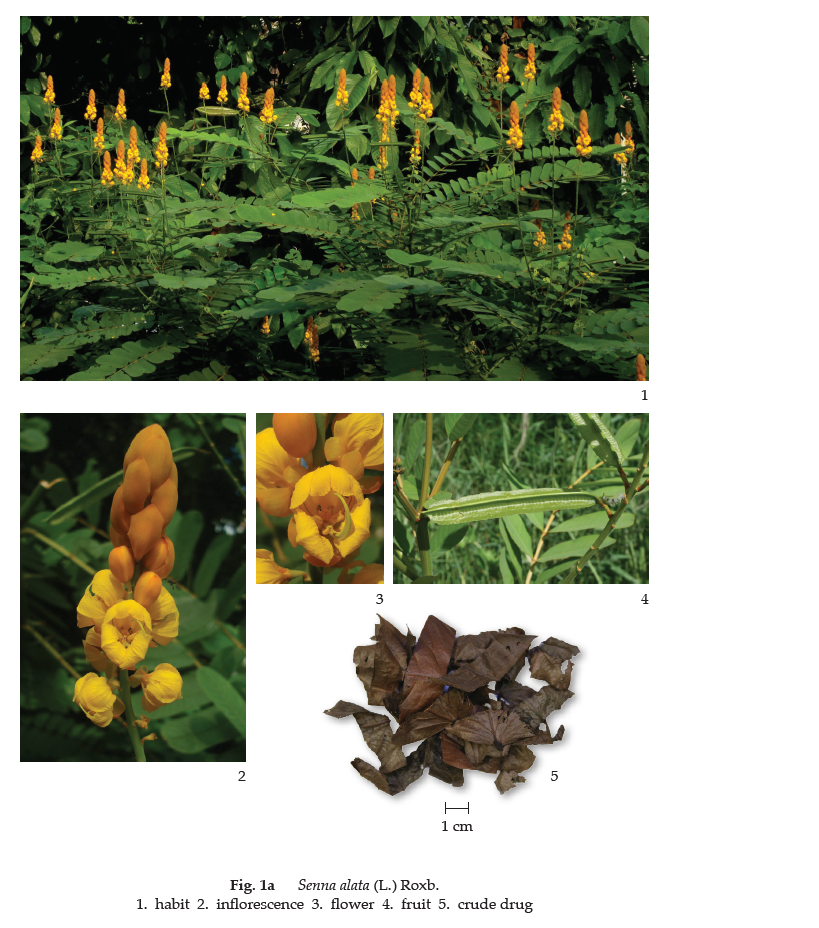
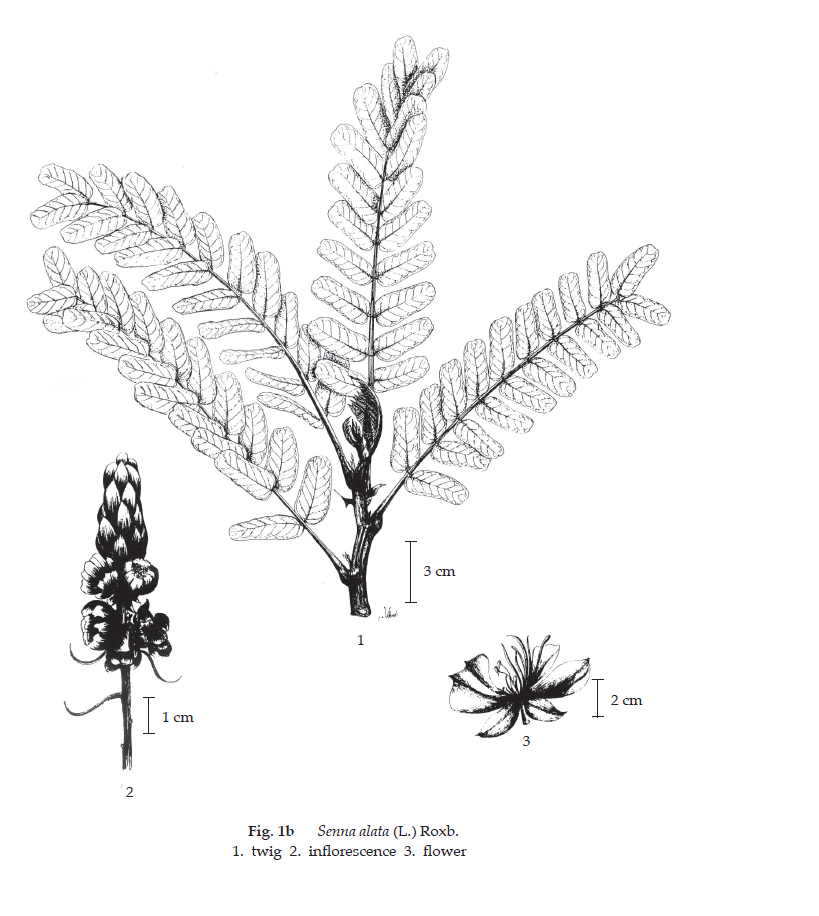
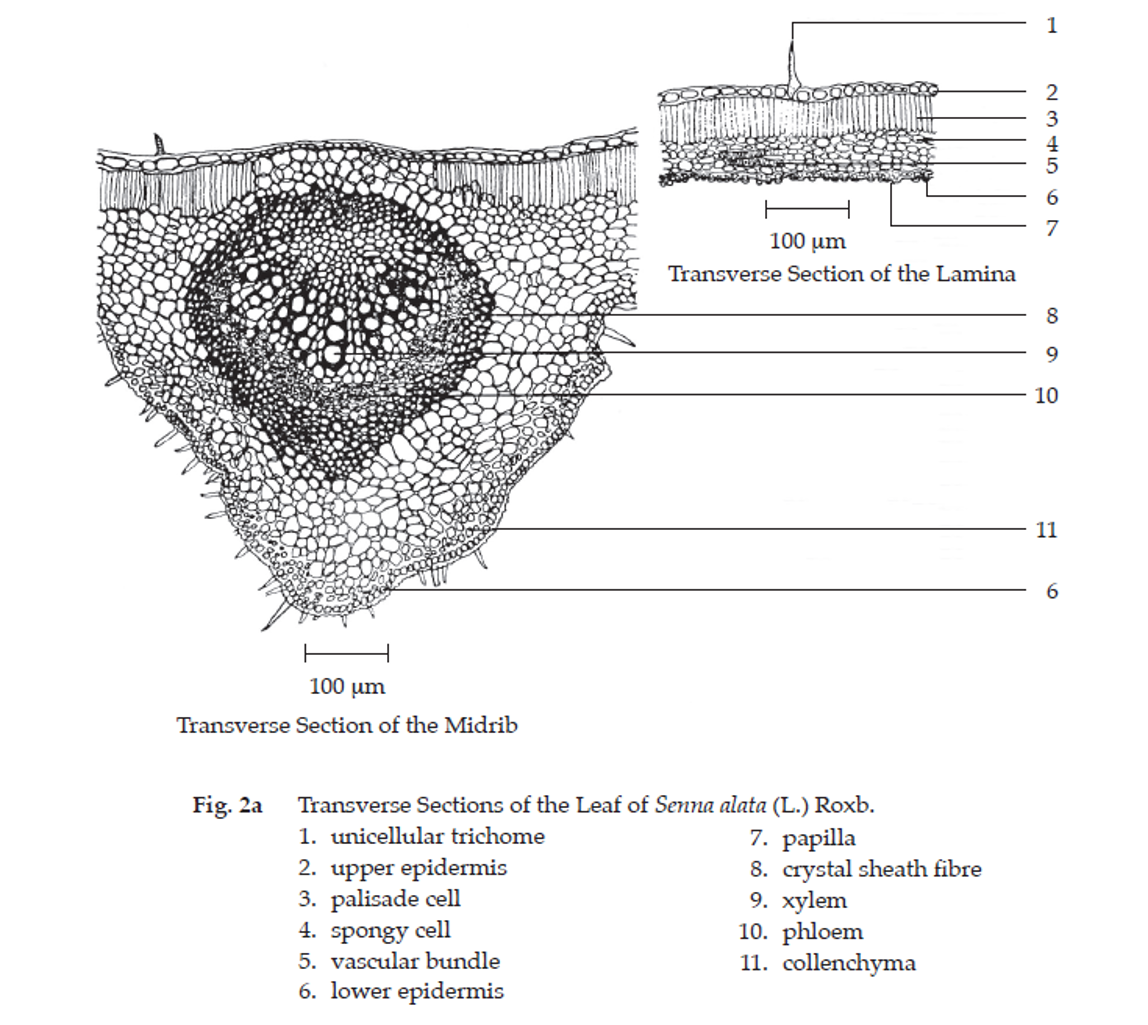
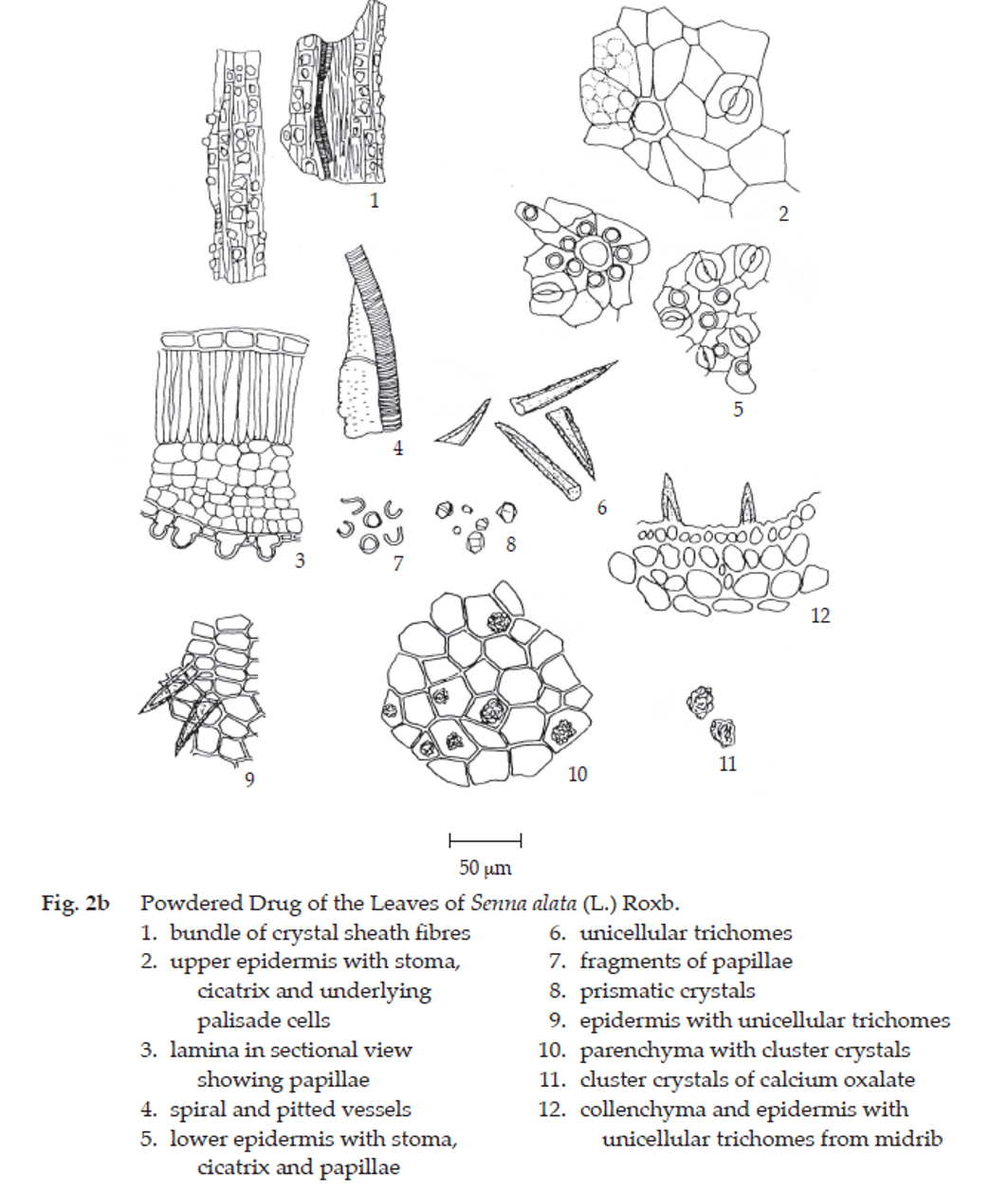
Senna Alata Leaf in powder possesses the diagnostic microscopical characters of the unground drug.
Warning
1. It should be used with caution in children, or in patients with inflammatory bowel disease.
2. It may cause mild abdominal discomfort such as colic or cramps. Excessive doses may produce nephritis.
3. Prolonged use should be avoided since it may result in diarrhoea with excessive loss of water and electrolytes, particularly potassium.
Packaging and storage Senna Alata Leaf shall be kept in well-closed containers, protected from light, and stored in a dry place.
Identification
A. To 100 mg of the sample, in powder, add 25 mL of 2 M hydrochloric acid, heat on a water-bath for 15 minutes, and immediately filter through a plug of cotton wool. Allow the filtrate to cool and shake with 20 mL of ether. Separate the ether layer and shake with 10 mL of ammonia TS: the aqueous layer becomes red.
B. Carry out the test as described in the “Thin-Layer Chromatography” (Appendix 3.1), using silica gel G as the coating substance and a mixture of 75 volumes of petroleum ether (boiling range, 40° to 60°), 25 volumes of ethyl acetate and 1 volume of anhydrous formic acid as the mobile phase and allowing the solvent front to ascend 10 cm above the line of application. Apply separately to the plate, 5 µL each of the following three solutions. Prepare solution (A) by refluxing 100 mg of the sample, in powder, with two 50-mL portions of chloroform on a water-bath for 15 minutes. Combine the chloroform extracts and evaporate to dryness. Dissolve the residue in 0.5 mL of chloroform. For solution (B), add 25 mL of 2 M hydrochloric acid to the marc obtained after the reflux and proceed as in the test for Identification A, beginning with “heat on a water-bath ...” to obtain the ether layer. Evaporate the ether layer to dryness. Dissolve the residue in 0.5 mL of ether. For solution (C) dissolve 1 mg of rhein in 1 mL of methanol. After removal of the plate, allow it to dry in air and examine under ultraviolet light (366 nm), locating the spots. The chromatogram obtained with solutions (A) and (B) correspond in hRf value and colour to that of rhein as shown in Table 1 or as of solution (C) (Table 1); see also Fig. 3. Expose the plate to ammonia vapour; the spots due to rhein are red. Other spots of different colours are observed (Table 1); see also Fig. 3.
Table 1 hRf Values of Components in the Extract of the Leaflets of Senna alata (L.) Roxb.
| Solution | Spot | hRf Value | Detection | |
| UV 366 | Ammonia Vapour | |||
| A | 1 2 3 4* 5 6 7 8 |
4-8 25-28 29-32 34-38 53-58 60-64 74-77 78-80 |
- - - orange - - - - |
pale green yellow yellow red pale green pale green pale green pale green |
| B | 1 2 3* |
2-4 25-28 34-38 |
- - orange |
pale brown yellow red |
*rhein
Loss on drying Not more than 11.0 per cent w/w after drying at 105° for 5 hours (Appendix 4.15).
Foreign matter Not more than 2.0 per cent w/w of stems and other foreign matter (Appendix 7.2).
Acid-insoluble ash Not more than 1.0 per cent w/w (Appendix 7.6).
Total ash Not more than 9.0 per cent w/w (Appendix 7.7).
Ethanol (50 per cent)-soluble extractive Not less than 21.0 per cent w/w (Appendix 7.12).
Water-soluble extractive Not less than 18.0 per cent w/w (Appendix 7.12).
Hydroxyanthracene derivatives content Not less than 1.0 per cent w/w of hydroxyanthracene derivatives, calculated as rhein-8-glucoside on the dried basis, when determined by the following method.
Accurately weigh about 150 mg of Senna Alata Leaf, in No. 150 powder, and place in a 100-mL round-bottomed flask. Add 30.0 mL of water, mix, weigh, and place in a water-bath. Heat under a reflux condenser for 15 minutes. Allow to cool, weigh and adjust to the original weight with water. Centrifuge and transfer 20.0 mL of the supernatant liquid to a 150-mL separator. Add 0.1 mL of 2 M hydrochloric acid and shake with three 15-mL portions of chloroform. Allow to separate and discard the chloroform layer. Add 100 mg of sodium hydrogencarbonate and shake for 3 minutes. Centrifuge and transfer 10.0 mL of the supernatant liquid to a 100-mL round-bottomed flask with a ground glass neck. Add 20 mL of a 10.5 per cent w/v solution of iron(III) chloride and mix. Heat for 20 minutes under a reflux condenser in a water-bath with water level above that of the liquid in the flask, add 1 mL of hydrochloric acid and heat for a further 20 minutes with frequent shaking, to dissolve the precipitate. Cool, transfer the mixture to a separator and shake with three 25-mL portions of ether previously used to rinse the flask. Combine the ether layers and wash with two 15-mL portions of water. Transfer the ether layers to a 100-mL volumetric flask and dilute with ether to volume. Evaporate 25.0 mL carefully to dryness at low temperature and dissolve the residue in 10.0 mL of a 0.5 per cent w/v solution of magnesium acetate in methanol. Measure the absorbance of this solution at the maximum at about 515 nm (Appendix 2.2), using the magnesium acetate solution as the blank.
Calculate the percentage content of rhein-8-glucoside from the expression:
A × 0.4283/w,
where A = the absorbance of the substance being examined at 515 nm, and
w = the weight in g of the substance being examined.
Dose 3 to 6 g once a day at bedtime.
